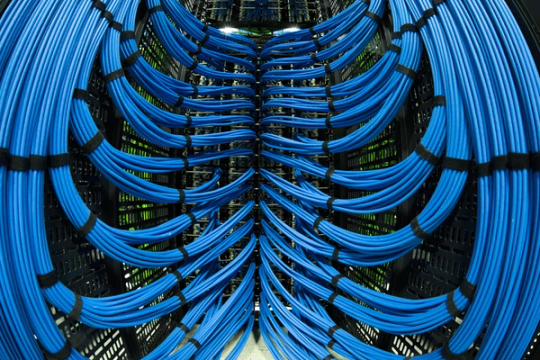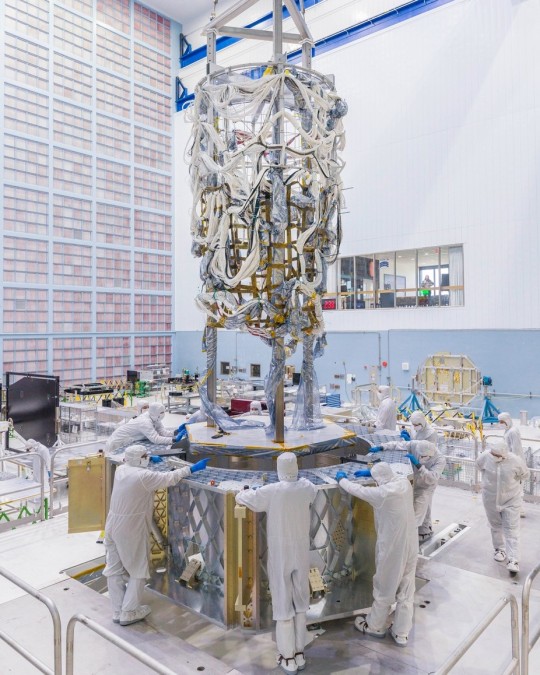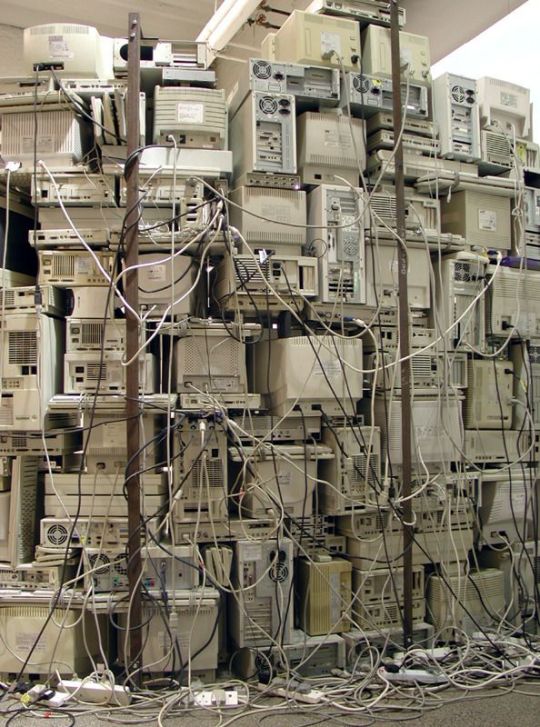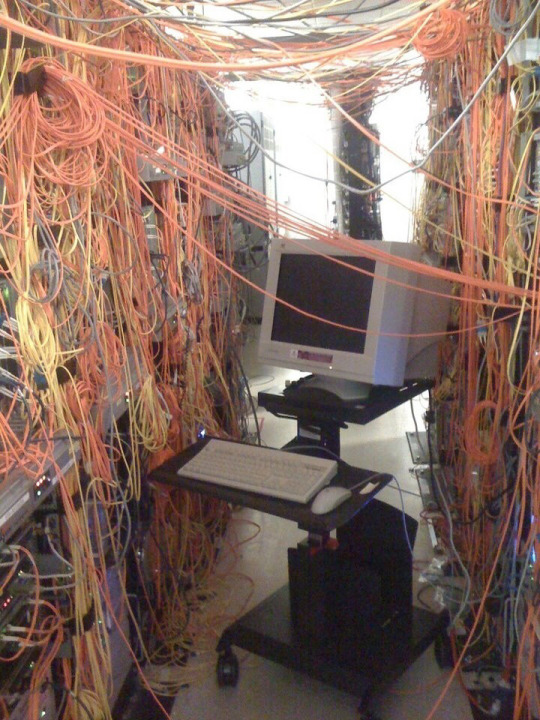#Hardware and Technology
Explore tagged Tumblr posts
Text

Ribs
#digitalismmm#digitalism#digital#tech#technology#techcore#machines#wires#religion#aesthetic#photography#art#computer#software#hardware#terminal#computing#photo
8K notes
·
View notes
Text

The Nancy Grace Roman Space Telescope’s flight harness is transferred from the mock-up structure to the spacecraft flight structure.
Your Body is Wired Like a NASA Space Telescope. Sort Of.
If our Nancy Grace Roman Space Telescope were alive, its nervous system would be the intricate wiring, or “harness,” that helps different parts of the observatory communicate with one another. Just like the human body sends information through nerves to function, Roman will send commands through this special harness to help achieve its mission: answering longstanding questions about dark energy, dark matter, and exoplanets, among other mind-bending cosmic queries.
Roman’s harness weighs around 1,000 pounds and is made of about 32,000 wires and 900 connectors. If those parts were laid out end-to-end, they would be 45 miles long from start to finish. Coincidentally, the human body’s nerves would span the same distance if lined up. That’s far enough to reach nearly three-fourths of the way to space, twice as far as a marathon, or eight times taller than Mount Everest!

An aerial view of the harness technicians working to secure Roman’s harness to the spacecraft flight structure.
Over a span of two years, 11 technicians spent time at the workbench and perched on ladders, cutting wire to length, carefully cleaning each component, and repeatedly connecting everything together.
Space is usually freezing cold, but spacecraft that are in direct sunlight can get incredibly hot. Roman’s harness went through the Space Environment Simulator – a massive thermal vacuum chamber – to expose the components to the temperatures they’ll experience in space. Technicians “baked” vapors out of the harness to make sure they won’t cause problems later in orbit.

Technicians work to secure Roman’s harness to the interior of the spacecraft flight structure. They are standing in the portion of the spacecraft bus where the propellant tanks will be mounted.
The next step is for engineers to weave the harness through the flight structure in Goddard’s big clean room, a space almost perfectly free of dust and other particles. This process will be ongoing until most of the spacecraft components are assembled. The Roman Space Telescope is set to launch by May 2027.
Learn more about the exciting science this mission will investigate on X and Facebook.
Make sure to follow us on Tumblr for your regular dose of space!
#NASA#astronomy#telescope#Roman Space Telescope#engineering#space hardware#dark energy#dark matter#space#technology#tech#universe
4K notes
·
View notes
Text

Computer Metropolis
#art#nostalgia#1980s#vaporwave#aesthetic#vintage#magazine#1990s#neon colors#neon#illustration#retrowave#retro computing#retro tech#retro#tech#technology#computer science#computers#computer#90s aesthetic#80s aesthetic#80s#90s#software#hardware#artwork
443 notes
·
View notes
Text
Zorin OS's auto-brightness feature has this bug that I like to call "Brightness Runaway," where, if it's semi-dark in the room you're in, loading a webpage with a Light Mode UI will throw enough light onto you (and the things around you) that Zorin OS will think it suddenly got brighter in the room.
That causes the auto-brightness to raise itself, which causes more light to be thrown into the room. That causes the auto-brightness to think it got even brighter, which causes it to raise the brightness even more.
The brighter it gets, the more auto-brightness tries to raise the brightness, and the more auto-brightness tries to the raise the brightness, the brighter it gets, so eventually you end up sitting there like:

#rambles#tech#technology#computer#computers#linux#zorin#zorin os#gnome#ubuntu#gif#brightness#light mode#hardware
265 notes
·
View notes
Text
Serial Experiments Lain (1998)
Setting up the computer...
#scifi anime#cyberpunk anime#scifi#cyberpunk#computing#desktop#noir anime#technology#virtual reality#hardware
1K notes
·
View notes
Text

This is what my insides look like btw . In case anyone was wondering . ,,
#objectum#objectophilia#technology#technophilia#techum#tech#techcore#robot dog#robot fucker#robotics#robot#robots#gears#hardware#software#comship please interact#pro para#proshippers please interact#radqueer please interact#paraphiles please interact
348 notes
·
View notes
Text

#programmer humor#programming#geek#nerd#programmer#technology#computer#phone#mac#windows#os#operating system#website#web development#dev#developer#development#full stack developer#frontend#backend#software#hardware#html#css#meme#despicable me#gru#joke#software engineer#apple
420 notes
·
View notes
Text

USA 1993
#USA1993#TRIAX TECHNOLOGIES#HARDWARE#CONTROLLERS#IBM#C64#ATARIst#AMIGA#SNES#NES#SEGA GENESIS#SEGA MASTER SYSTEM#TRIAX TURBO TOUCH 360
110 notes
·
View notes
Text

#machine#mech#mecha#robot#machinery#robotics#cybernetics#android#zoid#cyborg#mechanical#cyberware#tech#automaton#droid#humanoid#exo suit#electronic#hardware#bionics#software#technology#cybertech
252 notes
·
View notes
Text

Steve Jobs, Apple's co-founder, didn’t contribute to programming or hardware design. Steve Wozniak, the technical mind behind Apple’s early products, and other employees recognized Wozniak as the inventor and Jobs as the marketing strategist.
#Steve Jobs#Steve Wozniak#Apple#programming#hardware design#marketing#invention#technology history#computer science#entrepreneurship#Brands
105 notes
·
View notes
Text

#internet#dial up#56k dial up modem#dial up modems#cybercore#cyberpunk#computers#hardware#history#infotech#information technology#technology#ausgov#politas#auspol#tasgov#taspol#australia#fuck neoliberals#neoliberal capitalism#anthony albanese#albanese government#eat the rich#eat the fucking rich#funny memes#dank memes#best memes#lol memes#memes#meme
556 notes
·
View notes
Text

How to hide wires in your workplace
#digitalismmm#digitalism#digital#computers#computing#wires#wire#machine#hardware#software#tech#technology#techcore#retro#aesthetic#photography#machines
3K notes
·
View notes
Text

OPT4048 - a "tri-stimulus" light sensor 🔴🟢🔵
We were chatting in the forums with someone when the OPT4048 (https://www.digikey.com/en/products/detail/texas-instruments/OPT4048DTSR/21298553) came up. It's an interesting light sensor that does color sensing but with diodes matched to the CIE XYZ color space. This would make them particularly good for color-light tuning. We made a cute breakout for this board. Fun fact: it's 3.3V power but 5V logic friendly.
#opt4048#lightsensor#colortracking#tristimulus#ciexyz#colorsensing#texasinstruments#electronics#sensor#tech#hardware#maker#diy#engineering#embedded#iot#innovation#breakoutboard#3dprinting#automation#led#rgb#technology#smartlighting#devboard#optoelectronics#programming#hardwarehacking#electronicsprojects#5vlogic
84 notes
·
View notes
Text

Data across the globe
#art#nostalgia#1980s#vaporwave#aesthetic#vintage#magazine#1990s#neon colors#neon#illustration#80s aesthetic#90s#90s aesthetic#80s#internet#hardware#software#retro computing#computer science#computers#computer#pc#retrowave#retro tech#tech#technology#amiga#electronic#synthwave
496 notes
·
View notes
Text
The cables of an infallible machine is the flesh’s perfect imitation of the feathers of an incorruptible angel, and as such I can only assume that the key to something greater than even divinity lies within that of which is yet to be constructed, but is inarguably mechanical .










#featuring my quasi-religious transhumanism and machine worship :3!#divine machinery#bad cable management#angels#biblically accurate angel#software gore#hardware gore#angelic#technology#machines#machinery#transhumanist#transhumanism#robot girls#<- me
114 notes
·
View notes
Text


Rare 1970s neon green transparent rotary dial telephone !
#vintage tech#techcore#cybercore#digicore#neoncore#nostagliacore#1970s#telephone#old tech#transparent tech#clear tech#transparent technology#clear technology#70s#80s aesthetic#neon#hardware#retro tech#transparent#retro gadgets#retro telephone#retro aesthetic#neon aesthetic#curators on tumblr#alt text#nostalgiacore#2000s#y2k#vaporwave#vintage phone
1K notes
·
View notes